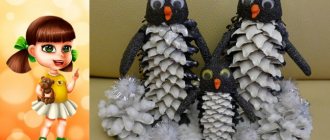Looking for Dinosaurs
Used Books.
1. “Dinosaurs and other extinct animals”, publishing house “Makhaon” 2005.
2. L. Watts, “Prehistoric Life”, Moscow, “Rosman” 1999.
3. I. Yakovleva, “Trace of the Dinosaur”, Moscow, “Rosman” 1997.
4. M. Avdonina, “Dinosaurs”. Complete encyclopedia, Moscow, Eksmo, 2007.
5. “All about dinosaurs”, publishing house “Astrel”, Moscow, 2000.
6. L. Cambournac, “Dinosaurs”. Children's Encyclopedia, Moscow, "Swallowtail", 2006.
Appendix No. 1
Memo for parents “Tell your children about dinosaurs”
Everything secret and mysterious always attracts children. The thirst for knowledge can be satisfied during search and research activities. We invite you to expand your children's understanding of dinosaurs - the most ancient animals on our planet. Of course, it is difficult for a child to remember all the names of dinosaurs, but it will be very interesting for him to hear the unusual names of these representatives of the fauna. We will need cardboard, colored paper, a CD, glue, double-sided tape and imagination.
1. On a landscape sheet, draw a sketch of the panel.
2. Transfer the details onto a sheet of colored paper. To do this, attach the sketch and colored paper to the glass and trace the parts of the dinosaur's body.
3. Cut out the outlined parts. A child can do this too.
4. Glue the cut-out parts onto paper of a contrasting color, add decoration (eyes, spots, webbed feet) and cut out, leaving a 2-3 mm border of contrasting paper.
5. Trace the disk on a sheet of cardboard, calculating its location in accordance with the sketch. So that the remaining details do not go beyond the framework.
6. Glue the dinosaur body parts, slightly extending beyond the outline of the disc.
7. Glue pieces of double-sided tape onto the disk, peel off the protective film and connect it to the outline of the base.
8. Draw the eyes with a marker or felt-tip pen and stick on the surrounding objects. Here you can use fragments of postcards and illustrations from magazines. This is the kind of beauty we get.
Master class “Such funny dinosaurs.”
What can we tell children about dinosaurs? Dinosaurs lived a very long time ago, several million years ago, when there were no people on Earth yet. They can be compared to crocodiles, turtles and snakes. These are huge animals that lived both on land and in water. Among them were herbivores and predators. Dinosaurs lived in all parts of the world, their remains are still found and skeletons are collected so that people can see the owners of forests and fields who lived millions of years ago. Why did they go extinct? There is still no exact answer to this question. Some scientists believe that the Earth has become very cold. Other experts believe that solid objects fell from space, raising clouds of sand and dust, which led to a solar eclipse and climate change. Still others prove that dinosaurs were poisoned by plants. Accompany your stories by looking at books and encyclopedias. Search and research activities can also be carried out on the street. Pre-prepare the dinosaur body parts by cutting them out of linoleum or plywood. Place them in a sandbox, sprinkled with sand. Tell your child that it is possible that there are dinosaur remains in your sandbox, and carefully try to “find” them using brushes and spatulas. Having found all the parts of the body, invite your child to assemble a model of a dinosaur and draw it at home or sculpt it from plasticine. Dinosaurs can be called “TV stars.” Many films are being made about the times of the Jurassic and Cretaceous periods, chilling the blood. Try to watch such films without children. Invite your preschooler to watch the animated series “Dinosaur Train.” Read fairy tales about dinosaurs: “The Tale of a Dinosaur named Clueless,” “The Tale of the Flying Dinosaur,” “The Tale of the Dinosaur Brothers.” Reinforce the knowledge gained by going to the zoo or creating dinosaurs with your own hands. You can make a notepad. From paper folded like an accordion, cut out the silhouette of a dinosaur your child likes. Staple the sheets of paper. Not only the child, but also his friends will like such a souvenir.
Research project “The Mysterious World of Dinosaurs”
Municipal preschool educational institution "Kindergarten No. 1 of Cheremkhovo"
Research project
"The Mysterious World of Dinosaurs"
| Author: Galiakhmetov Konstantin Born on September 14, 2013, MDOU “Kindergarten No. 1 in Cheremkhovo” Leaders: Gerasimenko Oksana Petrovna, Vlasova Natalya Vladimirovna, teachers, MDOU "Kindergarten No. 1 in Cheremkhovo" |
Cheremkhovo, 2021
Introduction
Paleontologists have long debated when dinosaurs lived and died out. When did dinosaurs live and why did they disappear are questions to which there is no clear answer. In my opinion this is a very interesting topic. Many questions about the life of dinosaurs still remain a mystery to us.
The relevance of my research lies in the fact that this is the past of our planet, and in order to look into the future, we need to know our past.
Goal: to identify the unique features of dinosaurs and the reasons for their extinction.
Tasks:
- Identify extinction hypotheses by using the Internet and researching scientific literature.
- Analysis of extinction hypotheses and determination of the true cause, assessment of the likelihood of identified events.
- Presentation of conclusions obtained as a result of the study.
Object of study: life of dinosaurs.
Subject of research: causes of extinction of dinosaurs.
Hypothesis: if dinosaurs became extinct, then there are several versions of this.
Research methods:
- Research (selection of material in accordance with the topic of the project, using scientific literature and Internet resources);
- Analytical – generalization of the obtained experiences and data;
- Practical (making a model);
- Presentation of research results.
Main part
The Greek word dinosaur means "terrible lizard". Dinosaurs were different huge and small. Small dinosaurs needed little food, so the “dwarfs” could live in any conditions.
There were several types of dinosaurs: predatory and herbivorous giants, flying and marine reptiles. The predators' teeth looked like sharp daggers. And herbivores were small and flat.
Seismosaurus is one of the largest herbivorous dinosaurs. Its front legs were shorter than its hind legs. Short legs helped support the huge body. The seismosaur most likely lived in the steppes or swamps. It fed on swamp vegetation.
Stegosaurus - length reached 8.5 meters, height exceeded 4 meters. These slow-moving land animals spent almost the entire day in the forest, plucking low vegetation, as well as the lower branches of trees. Stegosaurs had plates on their backs and four long, sharp spines on their tails, which could seriously injure an opponent.
Tyrannosaurus, the most fearsome dinosaur predator and the largest land predator to ever exist. A tyrannosaurus walked on two legs. He had a long and massive tail, which served as a support for the lizard's body. The length of the tyrannosaurus was 15 meters and the height was about 7 meters. The teeth reached 30 centimeters, which is half the length of an adult’s arm.
Practical part
There are about two dozen reasons for the extinction of dinosaurs. Here are the main ones:
1. The fall of a giant meteorite. Upon impact, a mass of dust rose into the atmosphere. The atmosphere turned out to be less transparent to sunlight for many years. In the ensuing darkness and cold, almost all the plants died. And after the plants from hunger and cold - all the dinosaurs.
2. The death of huge lizards came from Space, but the culprit of their death was not a meteorite, but a beam of “hard” radiation that our planet crossed.
3. Constant movements of continents and seas have led to significant climate changes. Warm conditions without any temperature changes gave way to colder nights and harsher winters.
Tropical vegetation has disappeared. Dinosaurs were forced to roam, move towards the equator in search of food, water, and warmth.
Volcanic explosions and earthquakes could have destroyed the dinosaurs. Or the first mammals to eat all the eggs of ancient reptiles. Although this theory is the most unlikely.
Conclusion
Based on the results of the research work, I made the following conclusions: it was global changes on our planet that caused the extinction of such unique creatures as dinosaurs. The movement of continents, climate cooling, changes in the composition of the plant world, meteorites, volcanic eruptions - all this played a decisive role in the fate of dinosaurs.
Studying literature and encyclopedias, I can say with confidence that my hypothesis was confirmed. There is no clear answer for what reason dinosaurs became extinct, and there are many versions.
To represent the lifestyle of dinosaurs, my mother and I decided to create a model that reflected their habitat. I plan to show this layout to the guys in my group, maybe they will be as interested in this mysterious world of dinosaurs as I am.
Literature
- Dinosaurs. The very first encyclopedia / Travina Irina Vladimirovna / 2018
- Gigantic children's encyclopedia of dinosaurs/Ermakovich D.I./Khomich E.O./2017
- ETC. Lyakhov Children's encyclopedia “I explore the world.”/2009.
- Ginny Johnson, From Diplodocus to Stegosaurus/Moscow, Astrel, 2001
- A collection of educational cartoons for children.
- Website about dinosaurs .https://dinozavr.info
- Wikipedia. wikipedia.org
Project "Dinosauria"
Anna Yurova
Project "Dinosauria"
Project passport
Project type : educational, research, creative
Type of project : group
Participants: children 5 years of age (middle group, teachers.
Implementation period: short-term
dinosaurs reigned on the planet . Due to natural disasters, they left behind fossilized skeletons and traces and distant descendants like turtles and crocodiles, which safely survived many earthly disasters.
One day Dima brought a new toy to kindergarten. It was a big dinosaur . The guys were very interested in this unusual animal. Children asked a lot of questions about when dinosaurs , what they ate, and how they reproduced. In this connection, it became clear that the topic of prehistoric inhabitants of the planet is of interest to the children of our group. And we decided to find out everything about dinosaurs , the time when they lived, and, of course, the reason for their extinction.
In order to broaden the horizons of children and develop cognitive interests, the idea arose of creating a mini-museum of ancient animals in the group.
The topic of prehistoric inhabitants of the planet is not given enough attention in kindergarten, but it arouses great interest among preschoolers. Therefore, this project will help support educational initiative, expand children’s knowledge about life on earth in ancient times, develop creative abilities in children’s artistic work, teach how to create models, and enjoy jointly created work.
Project goal : Formation of children's understanding of the era of dinosaurs .
Project objectives :
1. Develop imagination, creativity, creativity, curiosity of project ;
2. Maintain interest in the history of the origin of life on earth.
3.Form cognitive skills:
4. Create interest in cognitive activities.
5. Develop in children the need for knowledge about prehistoric animals, the characteristics of life, nutrition, body structure and types of dinosaurs , living conditions and the reasons for their extinction.
6. To form cognitive skills in children: compare, analyze, draw conclusions, classify, observe, reflect the picture of the prehistoric world in creative activities, etc.
7. Foster a caring attitude towards nature and animals.
The research problem was identified in the process of reviewing the encyclopedia “Animals of our Planet”
, the children asked a large number of questions, and therefore it became clear that the topic of the prehistoric inhabitants of the planet was poorly studied by children and was of interest.
During the implementation of the project , we asked ourselves the following questions:
Problematic issues:
"Who are dinosaurs ?"
"What did dinosaurs ?"
"How dinosaurs take care of their offspring?"
"Are there animals similar to dinosaurs ?"
The hypothesis of the study is that dinosaurs are very dangerous reptiles, but although they became extinct many millions of years ago, and the reasons may be different, the ancestors of dinosaurs live next to us , and which ones we will find out during the course of the study. Based on the problem considered, we can put forward the following hypothesis: dinosaurs are very dangerous creatures and there is no place for humans in the world of dinosaurs .
Work principles:
•The principle of conformity to nature: it is necessary to take into account the nature of the child - gender, age; build activities in accordance with interests and needs.
•The principle of interaction and cooperation between children and adults: participation in the organization of educational work of teachers.
Forms of work on the project :
· educational and research activities
· productive activity
· educational and gaming activities
· communicative and dialogue activities
Materials and equipment:
Additional literature, encyclopedias, game set of cards " Dinosaurs "
, didactic games
“
Dinosaur ” ,
“Herbivores or carnivores”
,
Dinosaur
Habitat ” , plasticine, album, creativity kit,
video "all about dinosaurs "
,plastic
dinosaur , pencils,
Links with other activities:
• Organization of educational activities (classes)
from the section
“Formation of a holistic picture of the world” (educational area - cognitive development)
.
• Conversations, observations, (educational areas: cognitive development, speech development, social and communicative development).
Expected result:
• Expanding children's knowledge about ancient animals inhabiting the planet.
• Fostering a caring attitude towards the animal world.
Improving work on interaction with parents, enhancing the position of parents as participants in the pedagogical process.
Project implementation stages :
I. Preparatory stage
1. Collection, analysis and systematization of information in accordance with the problem and objectives of the research.
2. Reading books, working with reference literature (in educational classes and in joint educational activities with the teacher and parents);
- selection and systematization of pictures, poems, drawings, listening to recordings of dinosaur ;
- educational conversations.
- educational activities.
3. Creative cognitive activity of children was presented:
- artistic activity;
4.Organization of work with encyclopedias: “Looking at illustrations”
Conducting a conversation on the topic:
“Who are
dinosaurs ?” 5. Collection, analysis and systematization of information in accordance with the problem and objectives of the research together with parents using additional literature, encyclopedias and Internet resources.
6. Active participation in the conversation on the topic: “Who are dinosaurs ?”
7. Creating a “ dinosaur ”
II. Practical stage
1. Teacher’s story on the topic “Ice Age”
2. Looking at illustrations about dinosaurs .
3. Organization of viewing the movie “ Dinosaurs ”
4. Solving riddles with children.
5. Carrying out an OOD layout “
Dinosaurs ” (application)
.
8. Organizing a moment of silence “Listening to a song about dinosaurs ”
.
9. Organization of games with dinosaur : “Catch up with the dinosaur ”
,
"Hook by the Tail"
.
10. Conducting a conversation “The most ferocious predator”
.
11. Conducting a conversation on the topic: “Why were they so big?”
,
"The Smallest Dinosaur "
.
12. Carrying out OOD-sculpting “ dinosaurs ”
13. Carrying out OOD-drawing “ dinosaurs ”
III. The final stage
1. Making a model of “ Dinosauria ”
.




